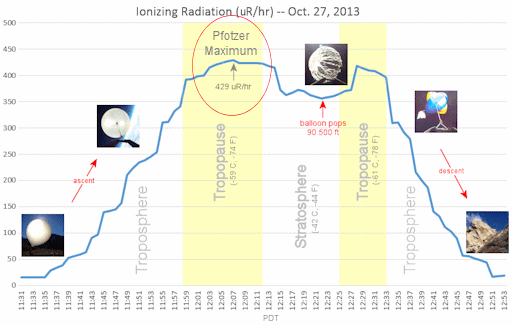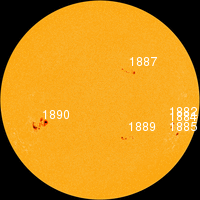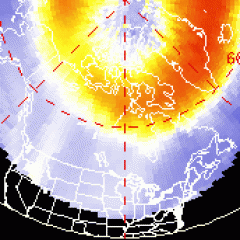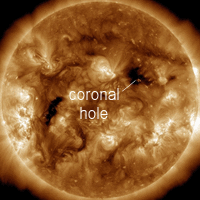~ Space Weather Update~ SOLAR FLARE CAUSES RARE 'MAGNETIC CROCHET X Class and M Class [1]
SUNSET PLANETS: When the sun goes down tonight, step outside and look southwest. Venus and the crescent Moon are having a get-together, less than 10o apart. Try to catch them before the sky fades to black. A Moon-Venus pair surrounded by twilight-blue is one of the prettiest sights in the heavens. [sky map [2]] [photo gallery [3]]
SOLAR FLARE CAUSES RARE 'MAGNETIC CROCHET': On Nov. 5th at 22:12 UT, the magnetic canopy of sunspot AR1890 erupted, producing a brief but intense X3-class [4] solar flare. NASA's Solar Dynamics Observatory recorded the extreme ultraviolet flash:
Radiation from the flare caused a surge in the ionization of Earth's upper atmosphere--and this led to a rare magnetic crochet [6]. Alexander Avtanski observed the effect [7] using a homemade magnetometer in San Jose, California. A magnetic crochet is a disturbance in Earth's magnetic field caused by electrical currents flowing in air 60 km to 100 km above our heads. Unlike geomagnetic disturbances that arrive with CMEs days after a flare, a magnetic crochet occurs while the flare is in progress. They tend to occur during fast impulsive flares like this one.
More eruptions are in the offing. NOAA forecasters estimate a 45% chance of M-class solar flares and a 10% chance of X-flares on Nov. 6th. Solar flare alerts: text [8], voice [9].
Realtime Space Weather Photo Gallery [10]
RE-DISCOVERING THE PFOTZER MAXIMUM: On Oct. 27th, when the students of Earth to Sky Calculus [11] launched a pair of radiation sensors to the stratosphere onboard a helium balloon, they didn't know what to expect. This just in: They have re-discovered the Pfotzer Maximum. Most people have never heard of it. The Pfotzer Maximum is a layer of peak radiation about 20 km above Earth's surface. Take a look at this data plot [12] from the team's space weather balloon and keep reading below for more information:
The plot shows a complete profile of ionizing radiation between 2.7 km and 27 km above Earth's surface. Data from their sensor counted X-rays and gamma-rays in the energy range 10.0 KeV to 20.0 MeV. A peak in radiation levels occured in the tropopause--that's the Pfotzer Maximum.
When cosmic rays crash into Earth's atmosphere, they produce a spray of secondary particles. With increasing depth in the atmosphere, the primary cosmic radiation component decreases, whereas the secondary radiation component increases. This complex situation results in a maximum of the dose rate at an altitude of ~20 km, the so-called "Pfotzer maximum," named after physicist George Pfotzer who discovered the peak using balloons and Geiger tubes in the 1930s.
The Earth to Sky experiment was prompted by a recent NASA report [13] concerning the effects of space weather on aviation. Like astronauts, ordinary air travelers can be exposed to significant doses of radiation when the sun is active. Data collected by balloon-borne sensors can be used to check and improve research models [14] of radiation percolating through Earth's atmosphere.
The students are ready to fly their sensors again. A radiation storm in the week ahead is a possibility as solar activity remains high. If one erupts, they plan to revisit the Pfotzer Maximum to find out how it reacts. Stay tuned. Solar flare alerts: text [8], voice [9].

Solar wind
speed: 351.8 km/sec
density: 5.4 protons/cm3
explanation [15] | more data [16]
Updated: Today at 1717 UT
X-ray Solar Flares
6-hr max: M3 1346 UT Nov06
24-hr: X3 2212 UT Nov05
explanation [17] | more data [18]
Updated: Today at: 1700 UT
![]()
Daily Sun: 06 Nov 13
Big sunspot AR1890 has a 'beta-gamma-delta' magnetic field that harbors energy for X-class [4] solar flares. Credit: SDO/HMI
![]()
Sunspot number: 134
What is the sunspot number? [20]
Updated 06 Nov 2013
Spotless Days
Current Stretch: 0 days
2013 total: 0 days (0%)
2012 total: 0 days (0%)
2011 total: 2 days (<1%)
2010 total: 51 days (14%)
2009 total: 260 days (71%)
Since 2004: 821 days
Typical Solar Min: 486 days
Update 06 Nov 2013
The Radio Sun
10.7 cm flux: 149 sfu
explanation [21] | more data [22]
Updated 06 Nov 2013
![]()
Current Auroral Oval:
Switch to: Europe, USA, New Zealand, Antarctica
Credit: NOAA/POES
![]()
Planetary K-index
Now: Kp= 1 quiet
24-hr max: Kp= 2 quiet
explanation [24] | more data [25]
Interplanetary Mag. Field
Btotal: 5.8 nT
Bz: 1.8 nT north
explanation [26] | more data [27]
Updated: Today at 1716 UT
![]()
Coronal Holes: 05 Nov 13
Solar wind flowing from the indicated coronal hole could reach Earth on Nov. 7-8. Credit: SDO/AIA.




